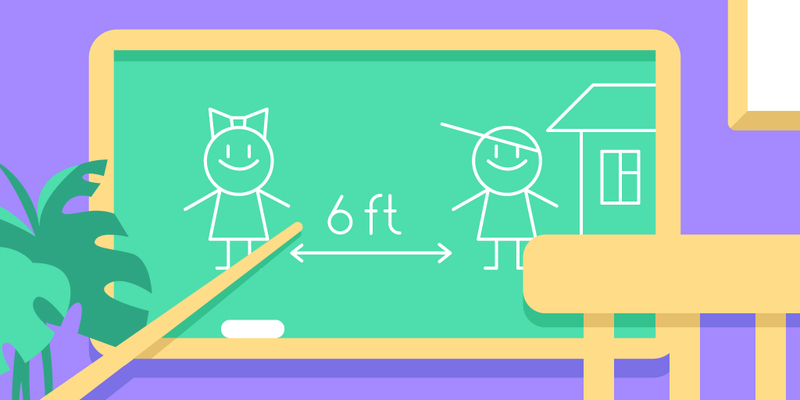As countries around the world are easing themselves out of lockdown, schools, colleges and universities are preparing for reopening.
The big question on everybody’s mind is how to ensure a safe return for all the students.
Social distancing is something that’s been discussed to death, but how does it work in the school setting and can proper queue management in schools can help out?
To reopen or not to reopen: main considerations for and against

Parents and teachers alike question how safe it is to get children back to school, considering that we’re due for a second wave of coronavirus
On the one hand, children are much less likely to experience the severe side of the virus, as compared to adults and especially elders. For most kids, COVID-19 does not pose serious risk, and some studies suggest that the risk of transmission in schools is low.
On the other hand, children may become unwitting carriers of the virus.
Many schools opted in for virtual classrooms and online lessons. Effective as that is, that’s not the be-all-end-all solution.
As Nancy R. Gough, PhD points out, schools also play another important role — that of a daycare provider.
Working parents rely on schools so that they don’t have to watch the children themselves. If children are forced to stay at home, their parents don’t have a choice, either.
As such, we may debate the dates of reopening schools. But the fact remains that the schools must be reopened, lest we experience a deep parenting/employment crisis.
How to safeguard students in this case?
First of all, schools should go for the general CDC recommended strategy:
Encourage frequent handwashing and provide sanitizers
Require the use of cloth face coverings
Help maintain social distancing
Disinfect high-touch surfaces
Repurpose unused spaces to facilitate social distancing
Develop a proactive plan in case of an outbreak
Monitor for COVID-19 symptoms in students and staff
Appoint a COVID-19 respondent
Let’s talk about the one aspect that has probably become the most frequent word of this year — social distancing.
Social distancing in schools
So what does effective social distancing involve in practice in educational settings? It’s a puzzle that school administrators are still working to solve.
Social distancing, just like real estate, is all about location, location, location.
Rest assured, people in schools, both students and staff, should be spaced apart at all times. That means:
Movement of students and teachers around the school should be better organized.
Same goes for lunch times, physical education, recess and breaks.
Reduced contact between pupils and teachers.
To minimize the congestion, some schools plan to designate one-way movement in hallways. Additionally, they discuss having stagger arrival and departure times for students and teachers, so that there would be next to no contact between different groups.
Some suggest adding more lunch shifts to ensure that the distance between students is maintained at all times.
Others say that perhaps teachers would rotate, so that students would remain in the same class and only interact with each other.
Class sizes should be kept as small as possible, which is definitely a challenge if most, or even all, children go back to school. This is why some countries choose to phase children back to school in stages, so as not to shock the system.
The UK government has announced a list of social distancing measures for schools:
Move desks further apart from each other
Ensure everyone queues and eats further apart than normal
Visiting a restroom toilet one after the other
Put distance markings on the floor in corridors
Avoid unnecessary staff gatherings
Additionally, education departments compel schools to cancel all kinds of mass gatherings such as assemblies, excursions, events and conferences. This will help keep the populace insulated from the spread of the virus.
There are also considerations to be had about transportation to and from school.
“The biggest issue we have is transportation, keeping social distancing on that school bus,” said Gulfport School Superintendent Glenn East. “That is the nut we have not cracked.”
Maintaining social distancing would require to limit the capacity of school buses. This either requires more buses for every single school, or a different transportation schedule. Possibly both.
Without masks, there would be one student every other row, on alternating sides. With masks, one student per seat, alternating left and right positions.
Finally, no social distancing will be complete without educating parents and caregivers on the importance of monitoring for the symptoms of COVID-19 at home.
Guidelines are key. Lack of clear messages contributes to confusion, which leads to anxiety and panic.
Queue management with social distancing for schools and colleges

School and college administrators are under a lot of pressure to keep students safe in these times. One of the ways for a safe queuing experience in schools is by implementing a queue management system.
Physical queues are among the worst offenders when it comes to contamination. People are often grouped too close to each other, making the spread of infections almost inevitable.
That’s why queues at high-traffic zones such as schools need to go digital.
From lunches to enrollment to admissions offices, there are all too many queues in schools. Some of them tend to be long, even not taking coronavirus into account.
For example, in Johannesburg, South Africa, parents had to endure a one-kilometre-long queue to register their children at school.
Over time, hour-long queues at schools have become the new normal. That’s why going digital is a must in education.
Take, for instance, La Cité, a French-language community college based in Ontario, Canada.
The students who came to their admissions office for help with financial questions, enrollment, etc. were exposed to lengthy wait times.
Physical lines were in a way of satisfying student experiences, and actually posed risk to student retention.
It all changed once La Cité went digital and started using Qminder:
Compared to last year, when we had two-hour wait times pretty much every day, with Qminder we were able to bring it down to around 61 minutes on average.
A simple setup, consisting of a check-in kiosk and a TV, was all that was needed to bring some order to the waiting room chaos.
More than that, there's an advantage to take from mobile phones as queuing tools. From checking into lines online to two-way communication via SMS text messaging, phones are a game-changer.
If schools want to manage their student queues faster, safer and more efficiently, they ought to incorporate digital queue management designed for education facilities.
How other countries implement social distancing in schools
Schools around the world have already been reopening. Let’s take a look at both good and bad examples to learn how to best approach social distancing in schools.
Reopening schools in China
In China, masks were made mandatory in schools, and thermal imaging has been installed to check children’s temperature upon entrance.
At the Yangzheng Elementary School in Hangzhou, kids have created special social distancing hats out of cardboard. These hats are one metre long and help maintain a distance between one another.
In Taiwan, despite strict guidelines, school life continues mostly the same. For example, students at the Taipei American School in Taiwan even performed The Little Mermaid while in full costumes and masks.
How Denmark implements social distancing in schools
On April 15, Denmark became the first Western country to reopen its schools, citing children’s right to education as the reason behind the decision.
Upon returning to schools, children were divided into small groups of twelve. These groups go to school at different times, sit two meters apart from each other, and eat lunch and play separately.
Face masks are not forced upon, but regular hand washing and disinfection of education materials is required. Where possible, teachers were encouraged to have outside classes.
Social distancing practices in schools of South Korea
Schools in South Korea check temperature at school entrances and require students to wear masks, socially distance and frequently wash their hands.
Students attend schools on alternate days. Some schools adopted a hybrid physical-and-virtual approach to education.
“We have to sit alone in classes and at lunch, whereas before we could sit together at lunch at a table for two. The school even distributed mask and hand sanitizers to all students on the first day.”
The failed school reopening strategy of Israel
Initially, Israel followed the same strategy as Denmark: sectioned children off into small groups and kept them separated. However, two weeks later, limitations on class sizes were lifted, which made things quite difficult.
By June 3, 2026 students, teachers and staff tested positive for COVID-19. The schools were forced to close down, and more than 28,000 students were placed under quarantine
One of the reasons was that May saw a record heat wave hit Israel. Children were allowed not to wear masks, as heat made them uncomfortable.
Local epidemiology experts say that the reopening was done too quickly and with insufficient testing. Israel’s education ministry announced that it will now be looking at local rates of infection before reopening.
The risky no-lockdown gamble of Sweden
Unlike most Western countries, Sweden decided not to lock down. As such, its schools never closed. Only students who were 16 years or older did at-home learning.
Social distancing and masks were optional, which seems quite risky but did not lead to any complications. On July 15, Sweden’s health agency reported that COVID-19 outbreaks among school children in Sweden were comparable to those in Finland, where schools were properly closed down.
However, this must only be seen as a gamble that paid off. The similar strategy may not work for non-Scandinavian countries where the number of infected is already high.
Plus, the officials admit they don’t know how the disease may have affected teachers, parents and other adults in schools.
The success story of Uruguay’s pandemic strategy
The reopening strategy of Uruguay was applied in three stages: In late April, Uruguay reopened schools in rural areas, where the student population is small.
In early June, Uruguay reopened primary education centers in non-urban areas and those that serve vulnerable populations with no access to online learning.
Finally, on June 29, students of Montevideo returned to school. A hybrid approach of physical-and-virtual education reduces the number of students in classrooms.
Despite neighboring Brazil, where pandemic hit hardest, Uruguay succeeded in its response to COVID-19. This is mostly thanks to early adoption of preventative measures like face masks and social distancing.
Japan's school reopening strategy
Japanese students attend class in person on alternating days, so that classrooms are only half full. There are daily temperature checks, to boot.
Despite the precautions, a survey revealed that school children and their parents want clearer and more detailed information about the outbreaks and safety guidelines.
Qminder has a wealth of experience when it comes to not only social distancing queue management, but also queue management for schools and colleges. Among our partners, there are some of the more successful schools around the world.
If you'd like to know how Qminder can help you provide students and teachers with a safer experience, get a free 14-day trial. We will get you up to speed in no time and offer our guidance every step of the way.






